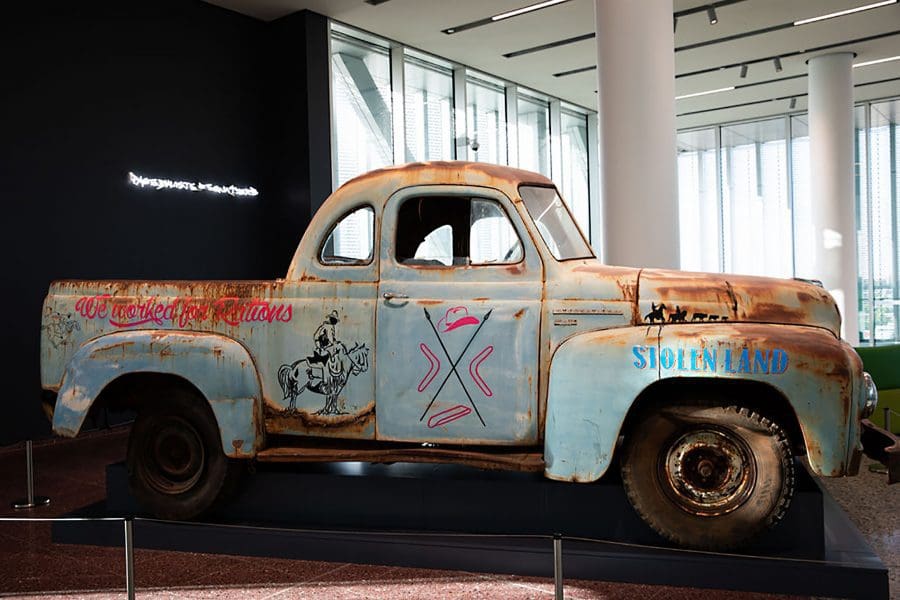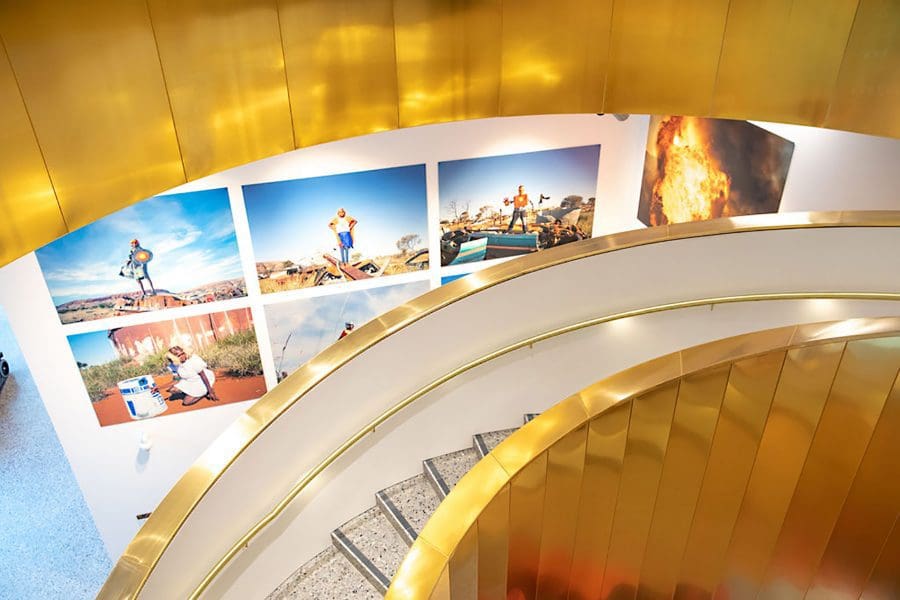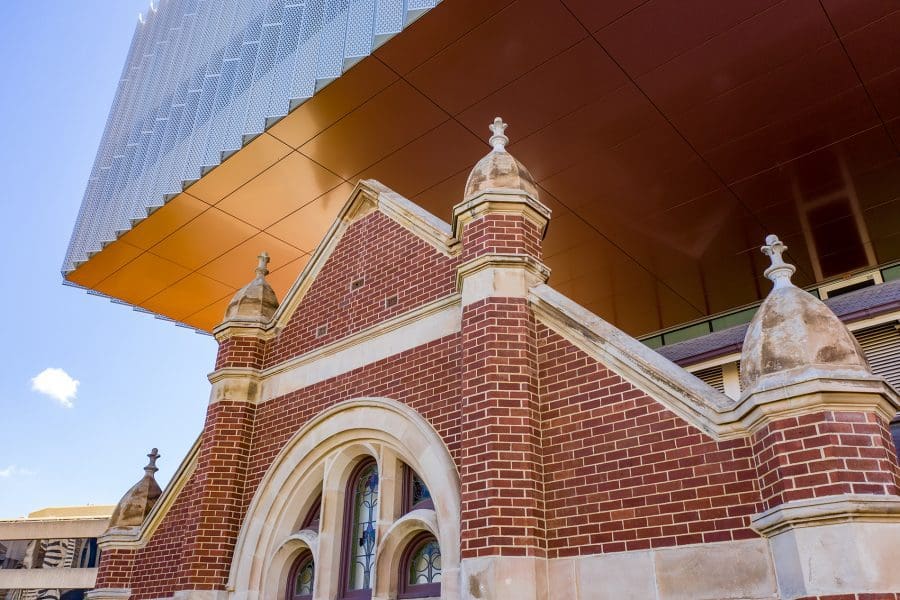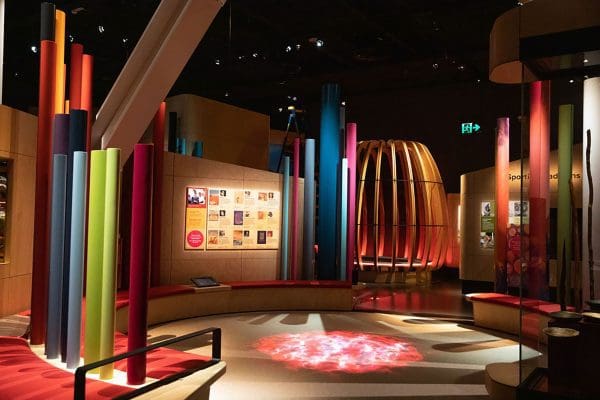
Piercing the veil
A new exhibition at Buxton Contemporary finds a rich complexity in the shadowy terrain between life and death.

We worked for rations, graphics & Stolen Land (a salvaged 1954 International AR 110 Truck, re-worked by Reko Rennie.)

Warakurna superheroes and gold stair case (c) Michael Haluwana, Aeroture.

WA Museum Boola Bardip Hackett Hall and cantilever (c) Michael Haluwana, Aeroture.

WA Museum Boola Bardip heritage and new (c) Michael Haluwana, Aeroture.
Perth Cultural Centre has always been an important gathering place: a centre for cultural lore and storytelling. 250 years ago, before the local culture and environment were abruptly and irrevocably altered by white colonisers, the Northbridge site was part of a large network of freshwater lakes and wetlands. This important and skilfully-managed ecosystem operated as a food bowl and cultural hub for the Whadjuk Nyoongar people.
“For thousands of years, my old people used to rely on the wetlands, freshwater springs and ochre pits that surround the area where the Museum stands today,” explained Brett Nannup, a Binjareb Nyoongar man and the museum’s anthropology registrar, in 2001. “When food was abundant, Nyoongar people gathered to share in the rich and diverse plant and animal resources, practice their lore and cultural rituals and catch up with family and friends.”
On this place now sits the Western Australian Museum. Since 1891 the museum has operated from this site in an expanding collection of heritage buildings, connected with slightly ad-hoc arrangements of stairs, lifts and walkways. Many locals will fondly recall beloved artifacts: the majestic blue whale skeleton, crystal geodes and phosphorescent rocks, the taxidermied bison.

Between late 2016 and November 2020, the museum was closed to the public while a massive construction and conservation project was underway. The intervening four years saw huge cultural shifts, including the resurgence of the Black Lives Matter movement worldwide; and the museum’s reopening has signalled a renewed focus on deeper understanding and recognition of the state’s most important heritage.
On an architectural level too, it is an impressive feat. The new complex enfolds and connects four heritage buildings, built between 1855 and 1913, that make up the core of the museum. As the new museum project director Trish McDonald explains, a key challenge was to unify these “four different heritage buildings with different floor levels into an accessible, integrated building.” The new design creates “horizontal and vertical loops” that allow multiple pathways around the museum. It also increases the museum’s space threefold.
Importantly, the new museum also has a new name: Boola Bardip. “Boola Bardip means ‘many stories’ in Nyoongar language,” says Trish McDonald, the new museum project director. “The name recognises that the Museum sits on Whadjuk Nyoongar land and honours the cultural heritage of Australia’s First Peoples.”
From its name onwards, the museum has used this renewal project to centre the Aboriginal peoples of Western Australia in its narratives of place, culture and history. A major permanent exhibition, Ngalang Koort Boodja Wirn: Our heart, Country, spirit, brings together a breadth of history, stories and experiences from Western Australia’s more than one hundred cultural language groups. Crucially, the history, knowledge and practices of First Peoples are not siloed in this one space but woven throughout each of the eight permanent exhibitions.

The first two temporary exhibitions to open in the new museum also celebrate Aboriginal stories. Songlines: Tracking the Seven Sisters is an immersive exhibition that includes paintings, objects, installations and multimedia which come together to “trace the Seven Sisters’ journey across the deserts of Western Australia to the centre of the continent,” as McDonald explains. The other temporary exhibition is Yiwarru Kuju: The Canning Stock Route, which tells the stories of an inland cattle track that stretched for 1850 kilometres across the Western Australian deserts; from the Kimberley in the north to the state’s mid-west. The route passed through the Country of at least nine different cultural language groups, and its impact and ramifications are documented through paintings. Both Songlines and Yiwarru Kuju were originally developed by the National Museum of Australia in Canberra.
For an institution whose cultural funding comes primarily from the mining sector, an industry not exactly renowned for its sensitive handling of Aboriginal cultural heritage or environmental conservation, this refocus is both welcome and complicated. It is worth noting that one of the museum’s foundation partners is Rio Tinto, a mining company that – just six months before Boola Bardip’s opening – was responsible for the devastating destruction of a sacred cave at Juukan Gorge, a site of indescribable cultural and archaeological significance. That these narratives can coexist is surely evidence of the ongoing reparative work that must be done; that is, in some way, being done on this site, through many stories, contradictory and intertwined.
While the bison, geological specimens and blue whale skeleton are also back (the latter dramatically suspended, as though diving from the lofty ceiling of Hackett Hall), the most important stories are those that are still unfolding.
Songlines: Tracking the Seven Sisters and Yiwarru Kuju: The Canning Stock Route
WA Museum Boola Bardip
Until 26 April